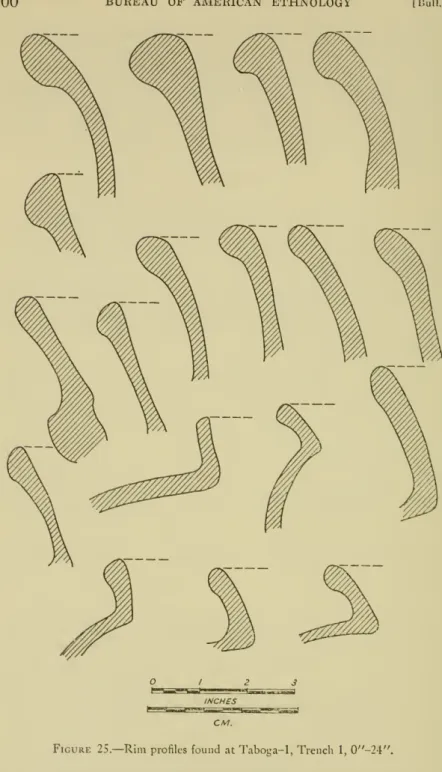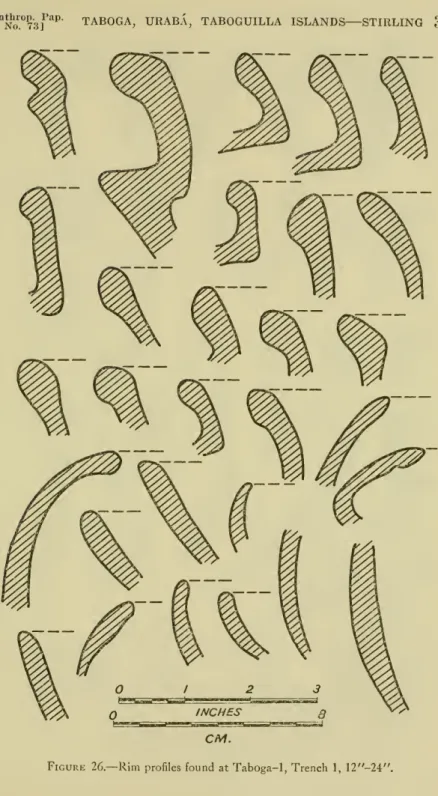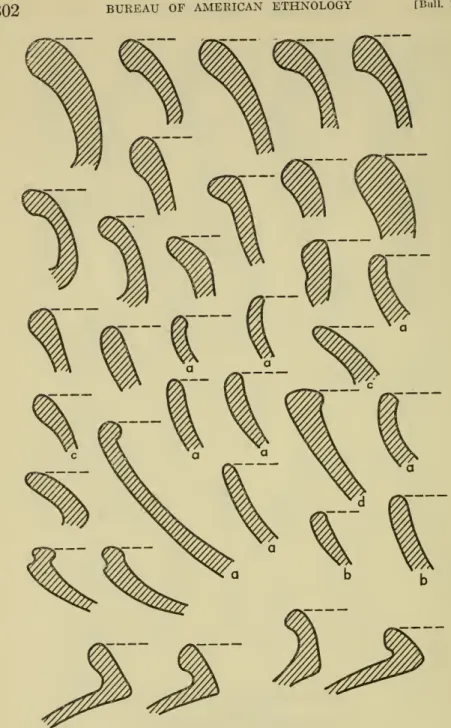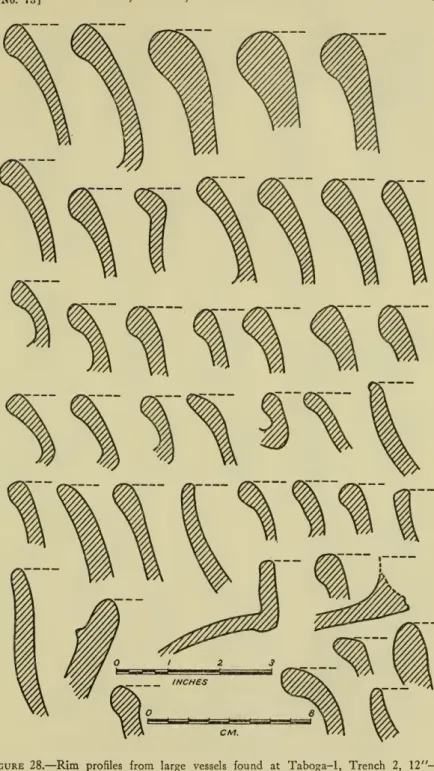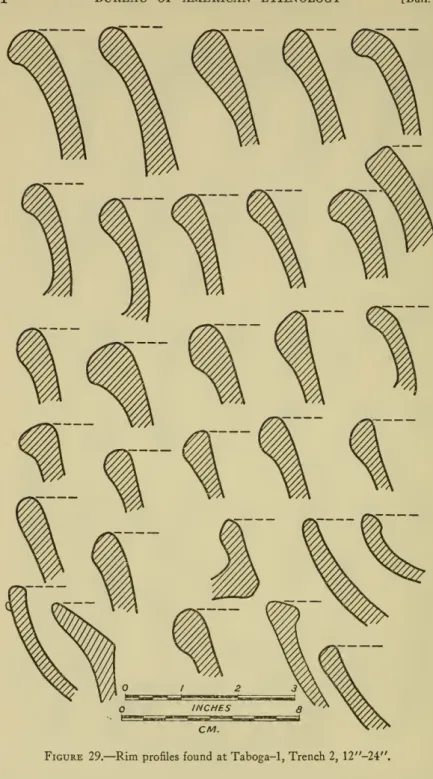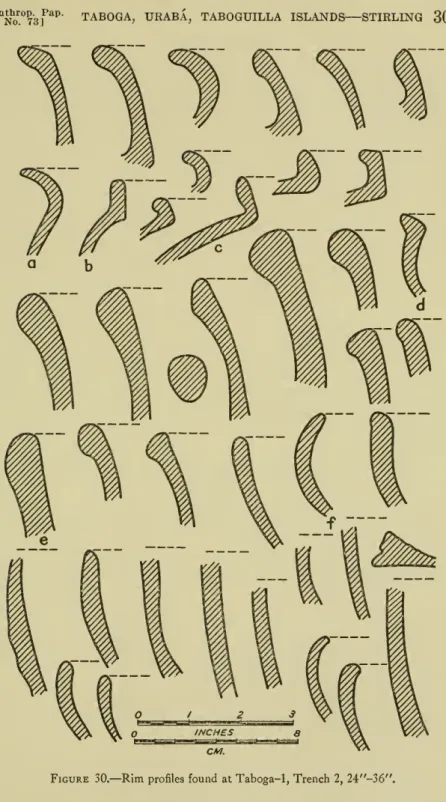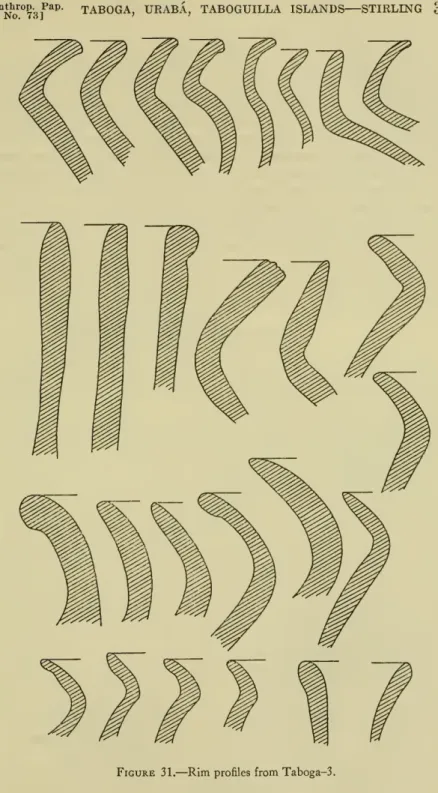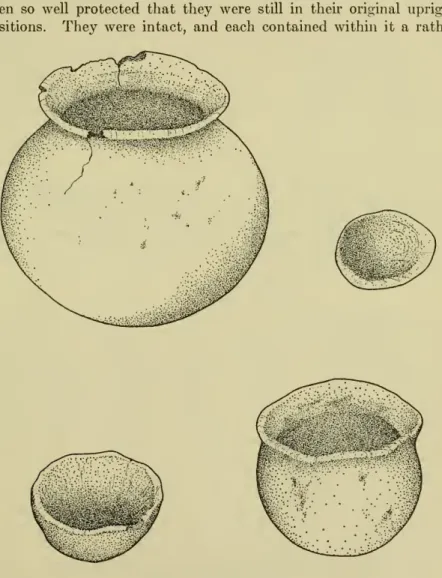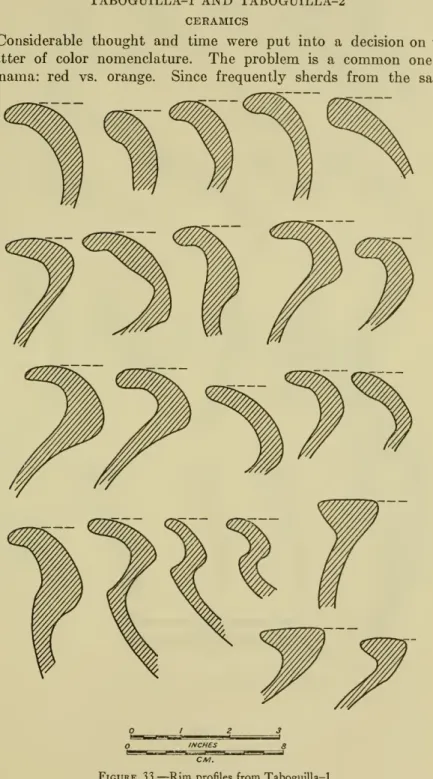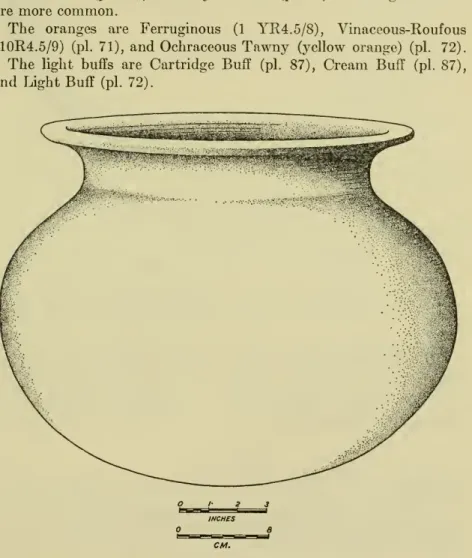SMITHSONIAN INSTITUTION
Bureau ofAmerican EthnologyBuUetin 191
Anthropological Papers,
No.
73THE ARCHEOLOGY OF TABOGA, URABl, AND
TABOGUILLA ISLANDS, PANAMA
By MATTHEW W.
andMARION STIRLING
285
682-611—64 24
CONTENTS
PAGE
Preface 291
Introduction 293
TabogaIsland 293
Taboga-1 296
Stone, bone,andshell 297
Ceramics 299
Pottery wares 306
Taboga-2 307
Taboga-3 307
Taboga-4 308
Taboga-5 310
Urabd. Island 310
TaboguillaIsland 312
Taboguilla-1 andTaboguilla-2 313
Ceramics 313
Painted wares 316
Incising 317
Indented 324
Applique 326
Handles 327
Pedestal bases 327
Tripods 327
Stoneandshell 327
Taboguilla-3 336
Referencescited 336
Explanationofplates 337
ILLUSTKATIONS
PLATES
(Allplatesfollowpage 348) 45.
Rim
sherdsfromlarge vessels;Taboga-1.46. Miscellaneoussherds;Taboga-1.
47. Paintedsherds; Taboga-1.
48. Various zoned designs;Taboga-1.
49. Miscellaneoussherds;Taboga-1.
50. Pedestalandring bases; Taboga-1.
51. Tabogastonework.
52. Taboga and Taboguillastoneandshell.
53. Miscellaneoussherds;Taboga-4.
54.
Rim
sherds; Taboga-4.55. Urabdurns.
56. Urabdurns.
287
288 BUREAU OF AMERICAN ETHNOLOGY
[Bull. 191PLATES—
Continued57. Siteson Urabd and TaboguillaIslands.
58. Boldincising; Taboguilla-1.
59.
Combing
andincising;Taboguilla-1.60. Incisedware; Taboguilla-1.
61. Variousrim decorations;Taboguilla-1.
62.
Narrow
line combing; TaboguiIla-1.63.
Combed
ware; Taboguilla-1.64. Fragmentsofglobularbowls decorated with
combed
designs; Taboguilla-1.65. Multipleline combing; Taboguilla-1.
66. Scallopimpressions; Taboguilla-1.
67. Filletingon
combed
surface; Taboguilla-1.68. Filletedware; Taboguilla-1.
69. Subglobular bowls withscallopindentedfilleting; Taboguilla-1.
70. CoUanders; Taboguilla-1.
71. Sherdswith bosseddecorations; Taboguilla-1.
72. Broadflatrimsofsubglobular bowls; Taboguilla-1.
73. Subglobular bowls withstrap handles; Taboguilla-1.
74.
Rim
sherdsoffiatshallowplates;Taboguilla-1, 75. Interior ofrim sherdsshown
onplate74.76. Micellaneouspaintedsherds; Taboguilla-1.
77. Black-on-orange-and-blackoutlined with white-on-orange; Taboguilla-1.
78. Black-and-white-on-orangepedestalbasebowlsherds; Taboguilla-1.
79. Reverseofplate78.
80. Pedestal basebowlsherds.
81. Sherdsfrom black-and-white-on-orangepedestal base bowls; Taboguilla-1.
82. Miscellaneous black-on-white-and-orangesherds; Taboguilla-1.
83. Miscellaneous paintedsherds; Taboguilla-1.
84. Miscellaneoussherds; Taboguilla-3 rockshelter.
85. Filletedandscallopimpressed ware; Taboguilla-2.
86. Miscellaneoussherds; Taboguilla-2.
87. Miscellaneoussherds;Taboguilla-2.
88. Miscellaneoussherds; Taboguilla-1.
89. Miscellaneoussherds;Taboguilla-1.
90. Taboguilla-3; rockshelter siteonTaboguilla.
TEXT FIGURES
PAGE
25.
Rim
profiles;Taboga-1 30026.
Rim
profiles;Taboga-1 30127.
Rim
profilesofred paintedware; Taboga-1 30228.
Rim
profilesfromlargevessels;Taboga-1 30329.
Rim
profiles;Taboga-1 30430.
Rim
profiles; Taboga-1 30531.
Rim
profiles;Taboga-3 30932. Smallpotswith miniaturesaucersfrom Urabd, 311
33. Taboguillarimprofiles 313
34. Taboguillarimprofiles 314
35. Restored Taboguillabuflfwarejar 315
36. Restored Taboguillabuflfwarejar 316
37. Restored Taboguilla ceramicbowl 317
"^°NJ!°7'3f'''''
TABOGA, URABA, TABOGUILLA ISLANDS — STIRLING 289 TEXT FIGURES—
ContinuedPAGE
38. Interiorof (figure37) 318
39. Restored Taboguilla orange-and-whitebowl 319
40. Restored Taboguillaincisedjar 319
41. Restored Taboguillaincised jar 320
42. Restored Taboguillaincisedjar 321
43. Restored Taboguillaincisedjar 322
44. Taboguillaincisedsherds 323
45. Restored Taboguillabuffware jarwithscallopindentedfilleting 324 46. Restored Taboguillabuffwarejarwithscallopindentedfilleting 325 47. Restored Taboguillaincisedjarwith applique crescents 326
48. Restored Taboguillapedestalbase bowl 328
49. Restored Taboguillapedestalbase bowl 329
50. Restored Taboguillapedestalbase bowl 350
51. Restored Taboguillapedestalbasebowl 331
52. Restored Taboguillapedestal basebowl 332
53. Restored Taboguillapedestalbase bowl 333
54. Restored Taboguillapedestalbasebowl 334
55. Restored Taboguillapedestalbasebowl 335
PREFACE
The
archeological investigationson Taboga, Uraba, and Taboguilla
Islandswere conducted
inMarch and
April of 1953 as part of the archeologicalprogram
inPanama under
the auspices of theSmith-
sonian Institutionand
theNational Geographic
Society.Accompanying
the expedition asphotographer, and
assistinggen- erally in thework throughout
the entiresequence
of expeditions toPanama, was Richard H.
Stewart, assistant chief of thePhotographic Laboratory
oftheNational Geographic
Society.We
areindebted
to anumber
of friendsboth
in theRepublic
ofPanama and
theCanal Zone
formaking our work
easierand more
efficient.
Mr. Karl
Curtis,longtime
residentof theCanal
Zone,gave
unstintingly of histime and knowledge
ofPanamanian
archeological sites.Mr. and Mrs. Paul
A.Bentz
kindly allowed us to use the largebasement
of theirhome
inBalboa
for the storage ofour specimens and
asawork
laboratory.Above
all,we
are obligatedtoDr. Alejandro Mendez,
director of theAluseo Nacional de Panama,
for his cordial cooperationand
assistanceduring
all ofour
archeological investiga- tions inPanama.
Others, toonumerous
tomention, gave
us assist-ance
inmany ways and
contributed tomaking our
stay inPanama
avery
pleasant one.We
are grateful toMr. Edward G. Schumacher,
artist for theBureau
ofAmerican
Ethnologj'', for thelinedrawings
in this report.291
THE ARCHEOLOGY OF TABOGA, URABi, AND
TABOGUILLA ISLANDS, PANAMA
By Matthew W. and Marion Stirling
INTRODUCTION
The
islands ofTaboga, Uraba, and
Taboguilla lie in theGulf
ofPanama some
12 milesfrom
the Pacific entrance to thePanama
Canal. All three are relatively steep
mountain peaks which
projectabove
thewaters
ofthegulfand, asaconsequence, thereisaminimum
of level
ground on them. Uraba and
Taboguilla lack freshwater during
thedry
season,and
as a resulthave
at the presenttime no permanent
inhabitants.Uraba
issmalland rocky and has very
little cultivable ground. Taboguilla is largerand has
a considerable area suitable for cultivationand some
springswhich
furnishenough water
fordrinkingpurposes
forallbut
2months
oftheyear.At
the presenttime
there are three or four small houseson
Taboguillawhich
areoccupied
temporarilyby
familiesfrom Taboga who have
plantationson
the island.TABOGA ISLAND
Taboga, about
2 miles in lengthand
1 mile in width, is the largest of the three islandsand
theonly one with permanent
habitations.There
isan ample supply
ofwater and
a smallbut good harbor with good
anchorage. It is avery
attractive placeand now
isfamed
as a pleasure resort.The
area of theBay
ofPanama extending from Taboga
to the Pearl Islands isone
of the world's finest fishing grounds, a factno doubt
exploitedby
the aboriginal inhabitants.In
fact, thename "Panama"
refers to the
abundance
of fish. Fishingnow
istheprincipalindustry ofTaboga
asitprobably was
inpre-Columbian
times.Judging from
thenature
ofthe archeologicalsites, the aboriginesmade
considerable useoftheshellfishwhich
occurinabundance and
considerablevariety.The
principal speciesused was
Aequipecten circularisSowerby, which
constitutesprobably
one-half ofthe totalshell content of themidden
deposits.
293
294 BUREAU OF AMERICAN ETHNOLOGY
[Bull. 191Because
of the lack of suitableanchorages
along themainland
of the
Isthmus, and because good water was not
readily available there,Taboga
earlybecame
akey
pointforthe trans-Isthmian traffic.Balboa
scarcelyhad reached
the PacificbeforeTaboga began
acolorful historymatched by few
spotsofequalsizein theNew World.
The
principalstream
ofwater on Taboga
flowsthrough
theonly
relatively level areaon
the island, that lyingimmediately back
of thecove and
beach.The
present village occupies this areaon both
sides of the stream, thehouses being
builtabout
as close together as possible. Since this is theonly
logical living siteon
the island, itwas
here also that the principal aboriginal settlementwas
located.Under
the present village lie theremains
of the old colonialSpanish town, and below
that themidden
deposits of the Indians.A
crosssection of this deposit is
exposed where
theramp from
thebeach
as-cends
to the firstnarrow
streeton
the village level.The church appears
tobe
builtover approximately
themiddle
of theIndian
village site.While
this sitewould be
naturally themost productive
location for archeological research, it is impracticable to dig in itbecause
of thebuUdings which
cover it.At
the presenttime
the surface of theground under and around
thehouses
is litteredwith
amixture
ofSpanish and Indian
sherds.Information concerning
the Indians inhabitingTaboga
at thetime
of theConquest
isalmost
nonexistent.Because
of the early settle-ment
of theislandby
theSpaniards and
itslimitedarea, it isprobable
that thebulk
of the nativeswere
killed or drivenaway
early in the 16th century.After raiding Parita
and
theAzuero Peninsula
in 1515,Badajoz and
his surviving followers fled toChame and thence
toTaboga
Island,
being
the firstEuropeans
toland
there. After nursing theirwounds
for severalweeks
in the security of the island,they returned
to themainland. Beyond
the fact that the island received itsname from Taboga,
the chiefwho
resided there,and
that theSpaniards obtained
22,000 pesos ofgoldfrom
the natives,we
learnnothing from
the early chronicles. It isprobably
safe toassume, however,
thatBadajoz obtained
the goldby
forceand
thathisvisitvirtuallybrought
toan end
the aboriginaloccupation
of the island.In 1519
Pedrarias,then Governor
ofPanama,
after taking posses- sion of thesouth
coast,brought
his force of400 men
toTaboga, from whence he
established the oldCity
ofPanama.
It is tobe presumed
that theSpaniards
alreadyhad
a settlementon
the island, for inNovember
of1524
Pizarro sailedfrom Taboga on
hisepoch-making voyage
of discoverywhich
led to theconquest
of Peru.In
1545,Pedro de
Hinojosa,dispatched by
Pizarro tocapture
Panama and
placeitunder
his control,outfittedand
repairedhisships^°NJ".°73r^^'
TABOGA, URABA, TABOGUILLA ISLANDS — STIRLING 295
at
Taboga from whence he conducted
hisnegotiationswith
thegovern-
ing officialson
themainland. Dm-ing
all of thistime
there isno mention
of Indianson
the island.In 1575
Dr.Alonso Criado de
Castilla stated that"Five
leaguesfrom
theCity
ofPanama was
the island ofOtoque, and
three leaguesfrom Panama was
the island ofTaboga; both
tilledand
cultivatedby some
inhabitants ofPanama who
plantedand harvested
corn."This would seem
to indicate that the aboriginal populationhad been
replaced in themain by
mestizosand
Spaniards.In
1610, in reply to queries sentout by
theSpanish Crown,
the followingitem
is of interest:The
districts aboutPanama
formerly hadmany
pueblos of Indians, but only threeremained. ThatofChepo waseightleaguestothe east....
Chepo had 40 Indianinhabitants,ruledbytheirown
governor, constable,and twomandadores.On
Isla delRey
[inthePearl Islands] to theeast, 18 leagues fromPanama
and6 leaguesfromTierraFirma wasanother pueblowhichusuallycontained 500 Indians but then only 12.The
third village of natives was on IslaTaboya
[Taboga] 4 leaguessouthofthe City with but12 inhabitants,who
were very poorlikethose of delRey.None
ofthese Indians paid tribute, and all spoke the Spanish lan- guage, havingentirelyforgottentheirown. [Anderson, 1938,p. 281.]Reference
to this patheticremnant
is the lastcontemporary men-
tion of the
Taboga
natives. It is certain that the Indianshad no
partin the hectic events thattook
placeon and about Taboga during
thenext two
centurieswhen
itwas
akey
point in the activities of thebuccaneers and
other freebooterswho roamed
theSouth Sea and
repeatedlyburned and sacked
thetown, which was always promptly
rebuilt
on
thesame
spot beside the clearstream which
here flows into the cove.In
1671,when Morgan sacked Old Panama,
theSpanish
refugees fledby boat
toTaboga and
Taboguilla. Itwas not
long after this thatCaptain
Searleswas
sent to capture theSpanish
treasure ship Trinity;he captured
itatTaboga. The
shipwas
poorlyequipped
for defense,but Taboga was
storedwith
"several sorts of richwines"
with which
Searles'men
"plentifullydebauched
themselves."By
the
time they had sobered
up, the Trinityhad
escaped.Even
as late as 1819Captain
Illingsworthand
hisgroup
of Chileanslanded on Taboga, where they
lootedand burned
the village.A number
of early descriptions of the islandhave been
left usby
the
more
literateof the buccaneers.That
ofCapt. William Dampier,
written in 1685,would
servevery
well to describe the Island today:The
24th daywe
run overto the Island Tabago. Tabago is inthe Bay, and about6 Leagues Southof Panama. Itis about3mile long, and2broad, a high mountainous Island.On
the north sideit declines with a gentle descent to the Sea.The Land
by the Sea is of a blackMold
and deep; but towards the top of the Mountain it is strong and dry.The
North side of this Island makes a296 BUREAU OF AMERICAN ETHNOLOGY
[Bull. 191very pleasant shew, it seems to be a Garden of Fruit inclosed with
many
high trees; the chief est Fruits are Plantains and Bonano's.They
thrive very well fromthefoot tothe middleofit;butthosenear the toparebutsmall, aswanting moisture. Close by the Sea there aremany
Coco-Nut-Trees, whichmake
a very pleasant sight. Within the Coco-Nut-Trees there growmany Mammet (Mame)
Trees.... The
S.W. end ofthe Islandhath never been cleared, butisfull of Firewood, and Trees ofdivers sorts. There is a very finesmall Brook
offreshWater, thatspringsoutoftheside of the Mountain,andglidingthrough the Groveof Fruittrees, falls intothe Sea ontheNorthside. There wasasmall
Town
standing by the Sea, with a Churchat one end, butnow
the biggestpart of it is destroyed by the Privateers.The
buccaneers under Sawkins lay here fromMay
2-15, 1680.['] Thereis goodanchoringrightagainsttheTown, about a mile from the shoar, where youmay
have 16 or 18 fathom Water, soft oazy ground. Thereis a small Islandclose bytheN.W.
endof this called Tabogilla [actually Urabd], with a small Channel to pass between. There is anotherwoody
Island about a mile on the N.E. side of Tabago, and a good Channel between them: this Island [Taboguilla] hath noName
that ever I heard.[Dampier, 1717.]
It is clear
from
the ratherabundant
literatureconcerning Taboga,
thatfrom
earliest times, togetherwith Taboguilla and Otoque,
itwas
the vegetablegarden and
fruitorchard
first forOld Panama, and
later toa
lesser extentfor themodern
city.It is interesting to
note
theapparent changes over
the centuries in the characterof the crops raised.In
1575, the principal cropwas
corn.
In 1685 Dampier
states that the chief cropwas
plantainsand bananas, but
alsomentions coconuts and mames. At
the presenttime
the principal crops are pineapplesand papayas, which
aregrown
in clearings
on
the steep hillsides.The
pineapples ofTaboga
arefamous
for their quality,and
it is local tradition that the original plantings for theHawaiian
Islandscame from
here.The
aboriginaloccupants
ofTaboga were probably moderately
prosperous, sinceBadajoz
lootedthem
ofafairly substantialquantity
of gold.A few
years ago,our workmen
told us, a gold"Corona,"
a plain
band
of goldabout
1 inch in width, tobe worn around
the head,was washed
out of thebank
of the creek.The
finders dividedit equally
among themselves by breaking
it into three parts.Lo-
throp illustrates several goldspecimens
said tohave come from Taboga.
With
the aid of nativeswe were
able to locate severalmidden
sites other
than
thatunderlying
thevillage.TABOGA-1
Near
the northeasternextremity
ofTaboga
is a small cove,back
of
which
islocated thestationfrom which
isoperated
aradar
installa- tionon
thesummit
of the island.Above
the station,atan
elevation»"Whilewewerehere," saysRiogrose(1684),"someofourmenbeingdrunkonshore,happenedto set fireunto oneofthe Houses,thewhich consumedtwelve housesmorebeforeanycould get ashoar to quenchit."
^"Noi^TSp"^'
TABOGA, URABA, TABOGUILLA ISLANDS STIRLING 297
of
about 350
feet, theground
levels offsomewhat
at a pointwhere an ephemeral stream runs
during thewet
season.On
this areagrow
anumber
ofmango and
lime treesand
afew coconut
palms.Taboga-1
is amidden
deposit consisting of amixture
of shellsand
black earthand
coveringan
areaapproximately
100 feet in dia-meter on
thesouth
slope of a shallowdry
ravine.About
6 inches of black soilcovered
themidden
deposit.Under
this the shell layer decreased indepth from
36 inches at the north, or lower,end
to24 inchesatthe
south
end.Under
theshellthe naturalbase was
avery hard packed mixture
ofrough
rocksand
clayey soil.We dug
a test trench into thisbase
to adepth
of 2 feetwithout
findingany
artifacts.
Trench
1was
laidout 20
feetX 20
feetand excavated
in four sections
each
5 feetX 20
feet in dimension.The
materialwas removed
in 1-foot layers0-12
inches,12-24
inches,and 24-36
inches.STONE, BONE, AND SHELL
Although
potsherdswere
fairlyabundant through
the depositand
stone artifactswere moderately common,
therewere no
artifacts of shell or bone. Shellswere abundant and
in considerable variety, 33 species being collected. Itisinteresting tonote that thespecimens from
themidden average
a considerably larger sizethan
thesame
species living in these
waters
today.The
followingwere found
inTaboga
1:^Gastropoda
Tegula (Tegula) pellis-serpentis
Wood
Neriia {Ritena) scabricosta Larricarck Cypraea (Macrocypraea cervinetto) Kiener Planaxis planicoslatus Sowerby
Siroinbus peruvianus Swainson StrombusgraciliorSowerby Strombiis granulatus Swainson Malea ringensSwainson Thais {Vasula) melones Duclos Muricanthusradix Gmelin Muricanlhus nigritusPhilippi Turbinella castaneaReeve
Fasciolaria (Pleuroploca) princeps Sovvrerby Fasciolaria (Pleuroploca) nalmo
Wood
MelongenapatulaBroderipand Sowerby Mitra {? Sirigatella) belcheri HindsVasum
caestus BroderipTerebrasp. (worn)
Terebra (Sirioierebruv) glauca Hinds
2Tlieidentificationsweremade byDr.R. Tucker Abbott. NomenclaturefollowsthatofA.M.Keen
(1958J.
298 BUREAU OF AMERICAN ETHNOLOGY
[Bull. 191Pelecypoda
CodakiadistinguendaTryon AreapadficaSowerby
Anadara (Larkinia) grandis BroderipandSowerby Anadara {Anadara) formosa Sowerby
Aequipeden (Plagioctenium) circularisSowerby Lyropecten (Lyropecten) subnodosusSowerby Ostreachilensis Philippi
Chama
frondosaBroderipTrachycardium (Trachycardium) consors Sowerby Periglypta multicostataSowerby
Chione (Chione) californiensis Broderip Protothaca grata Say
Megapitariaaurantiaca Sowerby
Baknacle: Tetraclitasquamosapanamensis Pllsbry
Fish bones were
presentinsome
quantity,but were not
asabundant
as
might have been
expected.The most common
shellfishwas
Aequipectencircularis,which
constitutedapproximately
one-halfofthe totalnumber. No mammal
or birdbones were
recovered.The most abimdant
stone artifacts consisted ofround
polishing stones,hammerstones and manos,
orgrinding stones, alladapted from
naturallyshaped beach
stones.One broken metate
legwas found
in layer0-12
inches.Three
rather crude,blunt
stone celtswere
found,two
inlayer0-12
inches,one
in12-24
inches.The manos were
ofno standard
shape,but
generally short ratherthan
long,and somewhat
flat in cross section.
The
polishing stonesand hammerstones
varied in sizefrom
that of agolf ball tosomewhat
largerthan
a baseball.In
the12-24
inch levelwas an
interesting gravermade from
a lamellar flake of yellow flint.Since the concentration of
midden
materialseemed
to increasetoward
thenortheast corner of trench 1we
laidout
trench 2,25X25
feet parallel totrench 1,
and
just to thenortheastofit.Over
aportion of this areawas
a stone rectangle, 19 feet square,which
layon
the surface, possibly ahouse
foundation.Some
of the stonesweighed from 200
to300 pounds
each.In
trench 2, themidden
layer variedfrom
32 inches in thickness along thewest
wall to24
incheson
the east wall.We
carried the excavation toan
actualdepth
of44
inches, finding thebase
material tobe
thesame
as in trench 1.We
could findno
traces of a floor or structureunder
the stone "foundation."In
general, the contents of themidden were
similar to those in trench 1,but
stone objectswere somewhat more abundant.
In the0-12
inch levelwe found two
legless metates;one
rectangular, the other oval.The
latterhad been worn
so thin that a holehad formed
in thebottom. In
this levelwas
also a smallbut
well polished celtwith
a sharp cutting edge, anumber
ofhammerstones and manos made from
^'^Noi^Tsf'^^''
TABOGA, URABA, TABOGUILLA ISLANDS — STIRLING 299
beach
stones,and
ayellowflintarrowhead
of therough
prismaticform
characteristic of
Veraguas and Code
sites (pis. 51, 52).In
the12-24
inch levelwas another
oval legless metute,and two
peculiarwell-made
large polished stone "axes" ofan
oval shape.In
this level therewas
alsoan
interestingcarved
stone bird effigy 7.5cm.
long (pi. 51),and
asecond
large prismatic flintarrowhead.
Near
thiswas
a deposit consisting of severalhundred unworked
sharks' teeth.CERAMICS
The
potsherdswere broken
into relatively smallfragments
inboth
trenches,and not
asinglecomplete
vesselwas
found.In
trench2 at adepth
of20
incheswas
asmallred-painted subglobularjar,broken
intomany
piecesbut almost
complete.Typical
potteryforms
are globularand
subglobularbowls with
restricted orifices, hemispherical bowls,and oUa shapes with
out- flaringrims
or collared necks.More
elaborate vesselswere
pedestaland
ringbase
bowls.Some
of the pedestal bases are shortand
squat, others talland
slender.The
pedestalbowls were
typically decoratedwith
blackand white
designson an orange
base.The
designswere sometimes on
the ex- terior,sometimes on
theinterior of the bowls. Frequently, red paint alonewas used on
the interior, the exterior, or both.Often
itwas
appliedonly
to the lip or theneck
of the vessel.Simple
designs in blackwere sometimes put on
thered base.There were two
types of red paint used;one
a truedark
red, the otheran orange which
variedin tonefrom
yellowish to red.The two shades
occasionallywere
appliedon
thesame
vessel to give a contrast- ing design.Sometimes white
orcream was used
as a base,with
designs in red or orange.In
at leastone
instance theorange
designswere
outlinedwith narrow black
lines.Modeled
designswere
infrequent.Some
subglobularbowls were
decoratedwith
curving, parallel, raised ridgesimpressed with
scallop shells.These
vesselshad
horizontal loop handles.Sherds from two
plain red
bowls
of thinhard ware were
decoratedwith rows
of raised bosses. Incisingwas
rathercommon and was
usually in connectionwith zoned
designs.Punctate
decorationswere almost
invariably of thezoned
variety.Large
ollas oftenwere
decoratedwith brushing
orscallopcombing,
especiallyon
the necks.The
best idea of the potteryand
decorative techniquescan be obtained from
the illustrationsand
plate descrip- tions.300 BUREAU OF AMERICAN ETHNOLOGY
[lUill. 191Figure 25.
—
RimprofilesfoundatTaboga-1,Trench 1,0"-2-l"."^"No'l^Tsf^^'
TABOGA, URABA, TABOGUILLA ISLANDS — STIRLING 301
CM.
Figure 26.—Rim profilesfound atTaboga-1,Trench 1,12"-24".
682-611—64 25
302 BUREAU OF AMERICAN ETHNOLOGY
[Bull. 191CM.
Figure 27.—Rimprofilesofred paintedware found atTaboga-1,Trench2,0" 12' .
"^^No^^T'sf^^
TABOGA, URABA, TABOGUILLA ISLANDS — STIRLING 303
Figure 28.
— Rim
profiles from large vessels found at Taboga-1, Trench 2, 12"-24"304 BUREAU OF AMERICAN ETHNOLOGY
[Bull. 191CM,
Figure 29.
— Rim
profilesfoundatTaboga-1,Trench2, 12"-24".^^NJ^^Tsf^^'
TABOGA, URABA, TABOGUILLA ISLANDS — STIRLING 305
CM.
Figure 30.
—
RimprofilesfoundatTaboga-1,Trench2,24"-36".306 BUREAU OF AMERICAN ETHNOLOGY
[Bull. 191 POTTERYWARES
Buf
ware.— There
are threeprunary
types ofware
atTab-1. Un-
slipped buff
ware
is themost abundant. The majority
of these vesselswere more
orlessglobularjarswith
short collarsand
outfiaringrim with thickened
lip.In
12 percent, the lips arepainted
red.Using Munsell
equivalents, the surface color variesfrom an orange
cast5YR
6/6, toa yellowishcastlOYE,
7/6.Sometimes both
of these variantscan be found on
thesame pot
as well as gray, orange,and brown
firing clouds.Therefore
the exactshade
isnot
particularly significant.The
exteriors of the pots generally are wellsmoothed.
In some
cases there are surface striationsfrom dragging
oftemper
particles
during smoothing. The
interiors arenot
as well finished.Some show narrow marks
of asmoothing implement such
as a pebble, orwider marks
asfrom
a gourd.The
surface is slightlyrough
to the touch,and
sherds thathave weathered
aresandy and
granularon
thesurface. It isprobable
that thisware was
self-slipped.Buff ware
varies considerably in the color of the paste. Itsome-
times is firedwith
agray
coreand
buffmargins
of equal thickness.Sometimes
thegray
core is95
percent,with narrow
buff margins.Occasionallyit is
completely
buff, evidentlyastheresult ofbeing
firedmore
heavily.These
variationshold
forvery
thin as well asvery
thick ware.Tempering
material is granularwith angular
particles,medium
to coarse in texture.
In some
instancestemper
isused moderately;
in others, heavily.
Flakes
ofwhite and
red usually aremixed
in.The
pottery doesnot break
evenly; the fractures arerough and
granular.Thickness
in buffware
variesfrom
6mm.
to 23mm.
Orange
Slipped.— The shapes
in general are thesame
as the buff ware, excepting that therewere
afew
shallowbowls with
outflaring rims.The
slip ismoderate orange 5YR
5/6with
splotches of lightbrown
5YR
5/6.The
slipped surfaces oftenshow
fine parallel ridges,made by
the polishing stone,which
arerough where
the sliphas weathered away.
Particles of
mica
glistenon
the surface.The
orange-slipped surface issmooth but not
slick.Unslipped
interiors are oftenrough and
granular.This
slipseems
tobe more
thinly appliedthan
is the red slip.The
paste is amoderate orange
in colorvarying
to lightbrown.
Frequently
the runs,and sometimes
the interiors, of thisware
arepainted
red.When
orange-slippedware
ispainted
red, the result is amuch
truerredthan
that seenon
red-slipped ware, eitherbecause
^^Noi^Tsf'''^'
TABOGA, URABA, TABOGUILLA
ISLANDS^— STIRLING 307
itis a thicker applicationor,
more
probably,because
itappears darker over
theorange
slip. It is a strong red,5R
4/10.Red Slipped.—
Shsipeswere
lessrestrictedthan with
theother wares.In
addition to the typical buffware
forms, therewere
globular jarswith
straight collarsvarying from
2 to 4cm.
in height.There was one bowl with
a thickened, incurving rim.The
slip varies in colorfrom moderate
reddish orange,lOR
6/8and lOR
4/10 tomoderate
reddishbrown
lOR, 4/8,and dark
reddish orange,lOR
5/8 or 5/6and 7.5R
4/10.The
exterior is wellsmoothed and
thered slip is polishedand
slick to the touch.Usually
the slip contains mica.The
interior issome-
timessmooth, but
often it is leftrough with
particles of thetemper protruding from
the paste.Marks
of the polishingimplement
are frequently visibleon
the surface, givingit a streaked,uneven
luster.The
slip itself ismoderately heavy and
is crazedand abraded
inmany
cases.In
color the paste isweak
yellowishorange lOYR
7/6 toweak orange SYR
6/6and
lightbrown 5YR
5/6. It generally is fired evenly.Red-slipped
potterywhich
isdecorated
isfinertempered and breaks
evenly.The
textureof thisware
isgenerallymedium
to coarsewith angular tempering
material including mica.In some
instanceswhite quartz
is
abundant
giving thefractures a"snowy"
appearance.Red-slipped ware
varies in thicknessfrom
6 to 12mm.
TABOGA-2
About 400 meters northwest
ofTaboga-1, and
at asomewhat
higher elevation, isanother occupation
sitewith
amuch
thinner deposit ofmidden
material.No
excavationswere made
here,but
a surfacecollectionshowed
that the potteryissimilar inmost
respects to that inTaboga-1.
There
isone
pedestalbase bowl painted red on both
the exteriorand
interior;another had black
stripeson
a redbase on
the exterior, while the interiorisplain.The one unique
sherdwas
amedium high
collarrim with
horizontalcombing on
the interiorand
verticalcomb-
ingon
the exterior. Itwas unpainted and had
aflat lip.One body
sherdwas
decoratedwith two notched
raised horizontallines.Our
conclusionwas
that theoccupation was contemporary with Taboga-1
.
TABOGA-3
On
thenorth
side ofthemain
arroyo that flowsthrough
thevillage,and about 600 meters northwest
of the last houses, is arock
shelter308 BUREAU OF AMERICAN ETHNOLOGY
[Bull. 191cave
at thebase
of a small cliffabout 200 meters from
the stream.It is
about
16meters
across themouth and
10meters
deep. It evidentlyhad been used
asan
offertory, orburial place,but we found no bones
in it.Although
the earthen floorwas about
1meter
in depth, the cultural material didnot extend below 25 cm. Potsherds were abundant, but
therewere no
shells or otherevidence
ofmidden
material.The
greatmajority
of the sherds consisted offragments
of large ollas,some with smooth, some with combed,
surfaces.The necks
of the ollas frequently aredecorated with
horizontalcombing
orwhat may be
cord impressions.A few body
sherdshad
a red slipon
the exteriorand one had
arow
of bossesaround
the shoulder,made by
pressingfrom
the interior.A number
of sherdswere
car-bonized on
the exteriorfrom
useon
the fire.Some bottom
sherdsfrom
large ollaswere up
to 4.5cm.
in thickness.TABOGA-4
Approximately 400 meters west
of the sandspit that joinsTaboga with El Morro
at thenorth end
of the island, there is a small valleywith
astream
that flowsonly during
thewet
season.About 200 meters above
themouth
of this stream,and approximately
50meters above
sea levelon
thenorth
side of the slope, is amidden
depositabout 40 cm.
deep.We excavated
a trench inapproximately
themiddle
of this, 8meters X
8 meters, saving allof the sherds.We were
struckby
the fact that the potterydiffers considerablyfrom
thatinTaboga-1.
Painted ware
consists typically of redand black
stripeson
a buff orcream
slip.Sometimes black
stripeswere on
ared
slip. Fre-quently
eithertheentire interioror exterior, or both,were
redslipped.The "red"
color variesfrom orange
to red.The more
elaboratelypainted examples were bowl
forms, frequentlywith
flatbeveled
rims.Larger
vesselswere
ollaforms
of buffware with
outflaringrims
or collared necks.The necks
usuallywere decorated with rough comb-
ing,
probably done with
theedge
of a scallop shell.Often
these vesselshad
the lippainted
red.Commonly
theoUa
bodieswere roughened by
brushing.Some
of themore
noticeable points of differencefrom Taboga-1 were
themuch
largerpercentage
ofcombed
orbrushed
ware, the lack of enlarged lips,and
theapparent complete
lack of incising.Stone
artifactswere
rare.There was one crude
celt of a bluishblack
stone,and
quiteu number
of flint chips includingone
long lamellarflake.A°tb'^oP„Pap.No. 73]
TABOGA, URABA, TABOGUILLA ISLANDS — STIRLING 309
Figure 31.
— Rim
profilesfrom Taboga-3.310 BUREAU OF AMERICAN ETHNOLOGY
[Bull. 191TABOGA-5
On
the precipitoussouth
side ofTaboga
there is acave
located directlybelow
the highestpartoftheisland. Itisabout
5 or6meters above high
water.There
isno beach
along thisexposed
part of the island.To
visit thecave we landed from our boat on
arocky
ledgeand
easilyreached
itby
skirting thelower
partof the cliff.The cave
slopesdownward
atabout
a20°
angleand
theentrance
is
not high enough
tostand up
in. Itseems
tohave been
ahigh
nar-row
cleft, the floor ofwhich has been
builtup with bat dung and by
material
washed
infrom
the hillside. It is quite dry.In
climbingup
the short talusbelow
themouth
of thecave we saw
anumber
of potsherds.The cave
isapparently
quitedeep and
is inhabited
by myriads
ofvampire
bats.We
didnot have
lightsand
therefore didnot
enter. It is quiteprobable
that it contains offerings,judging from
thepotsherds on
the talus.URABA ISLAND
The rocky and
precipitous islet ofUraba
lies to the southeast ofTaboga, from which
it is separatedby
anarrow but deep
channel.It
has no permanent water and but
littleland
suitable for cultivation.At
the presenttime
it isunpopulated.
Our Taboga
Island guidetoldus thathe knew
ofsome rock
shelters containinghuman bones and
largepotteryvessels inan
areasorugged
that itwas
practicallynever
visited.With an outboard motor we
leftTaboga, passed through
the channel, and, following thesouth
side of the islet, entered adeep hidden cove
at the southeast corner.From
this pointwe
cutour
way up
a steepspur
of themountain and down
to thenorth
side.Here
isan
impressive cliff ofmassive
basaltabout 60 meters
high.A broad
shelf at thebase
of the cliff iscovered with
a pile ofhuge angular
blocks of basalt fallenfrom
the cliff.We climbed through and over
this tangledmass
of stone,some
of the blocks as big as a small house.The
rocks areovergrown with
tropical treesand
thewhole
area is a roost forhundreds
of pelicans.Our guide asked
us towait
whilehe
located thesite,and
in 10minutes he returned
carry- ing a big oUa.He brought
us to a placewhere
three gigantic blockscombined
toform
arock
shelterabout 4X5 meters
in area.Open
in the middle, thereis
an overhang on both
sides.Looking down we
couldsee a
dozen
ormore
potteryollas,mostly
broken,but apparently
disturbedonly by nature
sincethey had been
placed there.About 30 meters north
of thismain
depository,we found another
containing three pots.We photographed
the offerings asthey
were, then, after cleaningout
theaccumulated
rubbish,photographed them
^''No'!°73p^'
TABOGA, URABA, TABOGUILLA ISLANDS STIRLING 311
again. All of the large ollas
were broken
tosome
extentand
inmany
instances pieceshad
fallen into crevices, orbeen covered by
small slabs of stone (pi. 57).
The
largestnumber
ofpotshad been
placedin thenorth
end,where they were somewhat
exposed.Others had been
placed farback under both
the eastand west
overhangs.At
theextreme
rear of the east side therewere fragments
ofhuman long
bones, wellchewed by
rodents. It
appeared
that thebones belonged
to a single individual.Under
the eastoverhang, which was a
sort of two-story affair,more
potswere
placed wellback on
themain
floor.On
the rathernarrow upper
floorhad been put two
small jars.These
latterhad been
so well protected thatthey were
still in their original upright positions.They were
intact,and each
contained within it a ratherFigure 32.
—
Small potswith miniature saucersfrom Uraba.312 BUREAU OF AMERICAN ETHNOLOGY
[Bull. 191crudely
made saucer-shaped miniature
vessel.As
nearly aswe
couldtell, there
were
23 potsin all.The
entire collection filled six large potato sacksand
it required threeround
trips forour two men
to transportthem
to the boat.Two oUas were
too large for the sacksand were
carried separately.Two
of the ollashad
traces of red paintand one
small vesselhad a simple geometric
pattern inblack painted on
the interior.The
pottery varies in color
from
lightbuff to brick red,and
isvery
hard.Considering
the size of themajority
of the vessels, thetempering
is
not
coarse.The
wall thickness of the large ollas generally variesfrom
5 to 13mm., but
thebaseson some
are26 mm.
thick.Approx- imately
one-half aredecorated with
ratherhaphazard combing, probably done with
a scallop shell.The remainder
aresmooth and
plain.
The
typicalshape
is that of around-bottomed
rathersquat
olla
with
outfiaring rim.One
largeand one
small vesselhad
a bevelaround
the widest part of thebody. The
small potswere made
ofthe
same type ware and were
similar inshape
excepting for thetwo saucer-shaped
miniatures placed inside small vessels as described above.The
large ollas varied in heightfrom 30
to40 cm. The
largestorifice
measured
33cm.
across (pis. 55, 56).It is evident that the pottery deposits
were
burial offerings,un- doubtedly
for bodiesbrought from Taboga. Bones apparently were not
placed in the urns,which presumably contained
food. It isprobable
thatUraba was uninhabited
in prehistoric timesbut may
have supported
limited cultivationby
the people ofTaboga
as itdoes
today.TABOGUILLA ISLAND
On Taboguilla
Islandwe excavated
three sites.Two
of these aremidden
depositson
thewest
side of the island.Taboguilla-1
islocated at
an
elevation ofabout
115meters above
thesand beach where,
at thetime
ofour
visit, afew unoccupied shacks were
located.Taboguilla-2
is atan
elevation ofabout
100meters almost
directlybelow
Taboguilla-1. Since thetwo
depositsseemed
to contain thesame type
of material,we excavated
a test trench inTaboguiUa-2
to
check on
this fact,and concentrated our
effortson
Taboguilla-1,which was
considerably largerand more
productive.The
refuse ofTaboguHla-l
, consisting ofblack
earthmixed with
shell,was somewhat more than
1meter
indepth.Potsherds were very abundant and
in agood
state of preservation.We conducted
the excavations stratigraphically,but our
statisticsshowed no change
in thetype
or proportions of the ceramics.We concluded
that themidden
repre- sented a singleoccupation over
anot very
considerable length of time.Taboguilla-3 is a rockshelter
about
200 meters south ofTaboguiUa-l.
Anthrop. Pap.
No. 73]
TABOGA, URABA, TABOGUILLA ISLANDS — STIRLING 313 TABOGUILLA-1 AND TABOGUILLA-2
CERAMICS
Considerable
thought and time were put
into a decisionon
thematter
of colornomenclature. The problem
is acommon one
inPanama:
red vs. orange. Since frequently sherdsfrom
thesame
Figure 33.
—
RimprofilesfromTaboguIlla-1.314 BUREAU OF AMERICAN ETHNOLOGY
[Bull. 191Figure 34.
—
Rim
profilesfromTaboguilla-1."^"No^Tsf'^^"
TABOGA,
ITRABA,TABOGUILLA ISLANDS STIRLmO 315
vessel
showed
a considerable variation inshade
(from reddishorange
to yellow orange)we
consideredgrouping
allsuch
colorsunder
orange.However,
definite oranges arefound on
interiorsand
exteriors of painted sherdsand
in several instances redwas
appliedon orange
asan
intentional color contrast.We
finally decided to retain the distinction of red, orange,and
bufT, givingMunsell
equivalentswith
the realization that certain vesselsshow
a considerablerange
in hue.The only
truereds areprobably
either the blackon
redtype
or those instanceswhere we have
redon
orange. Vesselsshowing
a color range, forexample,
are (pi. 71, a, c, d),which vary from dark
tones,Morocco Red
(pi. 58) toMadder Brown
(pi. 70),Brick Red
(pi. 70), KaiserBrown
(pi. 71),and Hay's Russet
(pi. 71).The
lighter tones aremore common.
The
oranges areFerruginous
(1YR4.5/8), Vinaceous-Roufous
(10R4.5/9) (pi. 71),and Ochraceous Tawny
(yellow orange) (pi. 72).The
light bufTs are CartridgeBufT
(pi. 87),Cream Buff
(pi. 87),and Light Buff
(pi. 72).Figure 35.
—
Restored Taboguillabuffwarejar.316 BUREAU OF AMERICAN ETHNOLOGY
[Bull. 191Figure 36.
—
Restored Taboguillaglobular buffwarejar.The browns
arefrom Brown-Bay
toBurnt Sienna
(pi. 59),Mars Orange and Liver Brown
(pi. 71),and
Sanford'sBrown and Hay's
Russet.The only
other colorsused were black and
white. All possiblecombinations
of these three colorswere used
atone time
or another.Although
there isno
inflexible rule, the different colorcombinations tend
to correlatewith
particular vessel forms.A
discussion of decorative techniquesfollows.PAINTED
WARES
Trichrome.
— The majority
of the trichrome vesselswere
pedestalbase
bowls.(a)
Black-on-white
exterior, black-on-orange interiorwith
theorange overlapping
the lip.A
variant of thishas
a plainorange
interior.
^°No?73f^^'
TABOGA, URABA, TABOGUILLA ISLANDS — STIRLING 317
/NCHES a CM.
Figure 37.
—
Restored Taboguillashallow buffwarebowl.(b)
Black-on-white
interior,orange
exterior.A
varianthas a white-on-orange
exterior.(c)
Black-on-orange
interiorand
exteriorwith white on
the base.(d) Black,
white and orange
exterior, black-on-orange interior.(e) Black,
white and orange
interior,orange
exterior.(f)
Black-and-white-on-orange
interiorand
exterior.(g) Black-and-orange-on-buff.
One
collanderhad
this decoration.Bichrome.
— These combinations
usuallywere
applied to high-necked
globular vessels.(a)
Black-on-white
exterior.(b)
Black-on-orange
exterior.(c)
Orange-on-white
exterior.(d) Black-on-red, interioror exterior.
Monochrome. — This ware
iscommonly
in theform
ofglobular potswith
outflaringrim.(a) Plain orange, interior
and
exterior.(b) Plain orange, exterior.
(c) Plain white, exterior.
INCISING
Bold
incising.— This
is afreehand
techniquewhere deep
parallel lineswere formed,
usuallyin curvilinear patterns.Light incising.
— This
is asomewhat more
delicate technique inwhich
parallel lines usuallywere
applied toform
a crosshatched design.682-611—64- -26
318 BUREAU OF AMERICAN ETHNOLOGY
[Bull. 191INCHES
CM.
Figure 38.
—
Interior offigure 37, restored,with blackpainted design.Narrow
line comhing.— This name has been given
to a stylewhere
acomb with
three or four tineswas used
toproduce
a special effect.Bands produced
in thisway were
vertical, horizontal, curvilinear, crosshatched, or squiggled.Multiple line combing.
— As
thename
implies, asharp comb with
more
teethwas
used.The
designs are less precisethan
innarrow
line
combing. Perhaps
tobe
considered a variationof this, iscombing
with
theedge
of apecten
or scallop shell.This
usually is applied rather lightlyand produces an
effect similar to brushing, as the lines arebroad and
shallow.'^°No?7'3r^^'
TABOGA, URABA, TABOGXnLLA ISLANDS — STIRLING 319
Figure 39,
—
Restored Taboguilla orange-and-white bowl; orange body, white shoulder, orangeinteriorandexteriorlip.Figure 40.
—
Restored Taboguillajarwithdeepmultiplelineincising.320 BUREAU OF AMERICAN ETHNOLOGY
[Bull. 191a
I
INCHES CM.
Figure 41.
—
Restored Taboguillajarwithdeepmultipleline incising.-^^t^JfoP-of^P-No. 73]
TABOGA, URABA, TABOGUILLA ISLANDS — STIRLING 321
2 S
1
I/NCHES 3 CM.
Figure 42.
—
Restored Taboguillajarwithdeepmultipleline incising.322 BUREAU OF AMERICAN ETHNOLOGY
[Bull. 191Figure 43.
—
Restored Taboguillajarwithdeep multipleline incising.^"Nif.'^Tsf^^'
TABOGA,
URABxV,TABOGUILLA ISLANDS — STIRLING 323
Figure'44.
—
Incised sherdsfrom TaboguIlla-1.324 BUREAU OF AMERICAN ETHNOLOGY
[Bull. 191INDENTED
The most common method
of indentingwas
to presswith
theedge
of a scallop shell. Indentations alsowere produced with
awedge- shaped implement. Ordinary punctate
designs,produced with
the point of asharp
instrument, are rare.Usually
thepunctations
are coarse.INCHES
CM.
Figure 45.
—
Restored TaboguillabuffwarejarwithscallopIndented filleting.^"{J'J'^^or^^'
TABOGA, URABA, TABOGUILLA ISLANDS — STIRLING 325
Figure 46.
—
Restored Taboguillabuffwarejarwithscallopindentedfilleting.326 BUREAU OF AMERICAN ETHNOLOGY
[Bull. 191APPLIQUE
Filleting.
— Raised
lineswere
applied horizontally, vertically,and
in curvilinear style.Frequently
the filletswere
plain;more
oftenthey were decorated by
indenting, eitherwith
a scallop shell ora wedge- shaped implement.
Animal
figures.—
Filleted designs occasionallywere
embellished furtherwith
stylized figures of lizards (alligators) or frogs.Bosses.
— Hemispherical
bosseswere used
rather frequently.Some-
timesthey were
isolated or in pairs,sometimes
placed close together in parallel lines orin ahaphazard
fashion.a INCHES
CM.
Figure 47.
